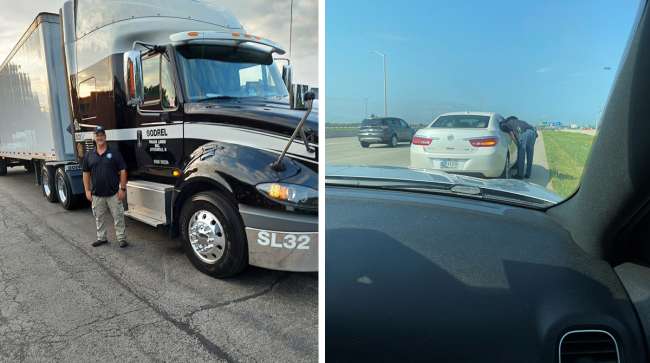Senior Reporter
Indiana ‘Trooper in a Truck’ Day Nabs Texting, Speeding Drivers

[Stay on top of transportation news: Get TTNews in your inbox.]
Who would have suspected that four tractor-trailers rolling down Indiana interstates earlier this month had a state trooper in the passenger’s seat?
Certainly not the nearly 300 motorists issued tickets and warnings who, unbeknownst to them, were under the watchful eye of a “trooper in a truck” observing their dangerous roadway behaviors.
The troopers in the trucks radioed to state police patrolling up ahead to be ready for these motorists, and to issue citations.
It might not surprise the men and women who spend hours each day in a truck cab that most of the 284 tickets or warnings — 75% — were issued to drivers in cars. In all, officers wrote 132 tickets and 152 warnings during the one-day operation on July 14.
“One of the things we hear from truck drivers is, ‘It’s a shame you guys can’t see what’s going on the way we can. If only you guys could see what we see in the seat every day being up high,’ ” said Major Jon Smithers, commander of the Indiana State Police Commercial Vehicle Enforcement Division.

Smithers
Which is a key reason for getting the troopers sitting up high in the truck. That way they could more easily see if motorists had cellphones in their hands, a violation of a state law that recently went into effect, Smithers said.
That day, the troopers were reminding motorists of the state’s no-nonsense “hands-free” law, which can carry up to a $500 fine and a levy of four points on a driver’s record.
Gary Langston, president of the Indiana Motor Truck Association, said the association helped police by recruiting the four tractor-trailers to travel looping interstates in different areas of Indiana. But the motor carriers who provided the trucks didn’t want to be publicly named.
“We think it was successful,” Langston said. “It continues to improve the relationship between law enforcement and the trucking industry. But first and foremost, it raises awareness and the priority level of safe driving. It reminds people that safe driving is a full-time job.”

Langston
Of the new law, Langston added, “We need to let these people know that we’re serious about this, because everybody’s still on their phones — nobody is taking it serious. We also focused on people driving erratically and unsafely around commercial vehicles, things like tailgating, cutting people off, and all the other things that cars do.”
Although the hunt was to find drivers texting and talking on phones while traveling the interstates, most of the citations actually were for speeding, Smithers said.
“I heard one story that a truck with a trooper was moving in the right-hand lane,” Langston said. “A car passed them on the right shoulder of the road, and then pulled in front of the truck. When they pulled the car over and asked the driver why he passed on the shoulder, his response was ‘What truck?’ That just tells you that people aren’t paying as much attention as we’d like for them to.”
Smithers added that too many drivers don’t realize just how dangerous texting or talking on a phone while behind the wheel can be.
“I don’t think people realize you can travel two or three lengths of a football field in just a few seconds,” he said. “If something is going on in front of you, in just a short matter of time you can be on top of a problem.”
Want more news? Listen to today's daily briefing below or go here for more info:




